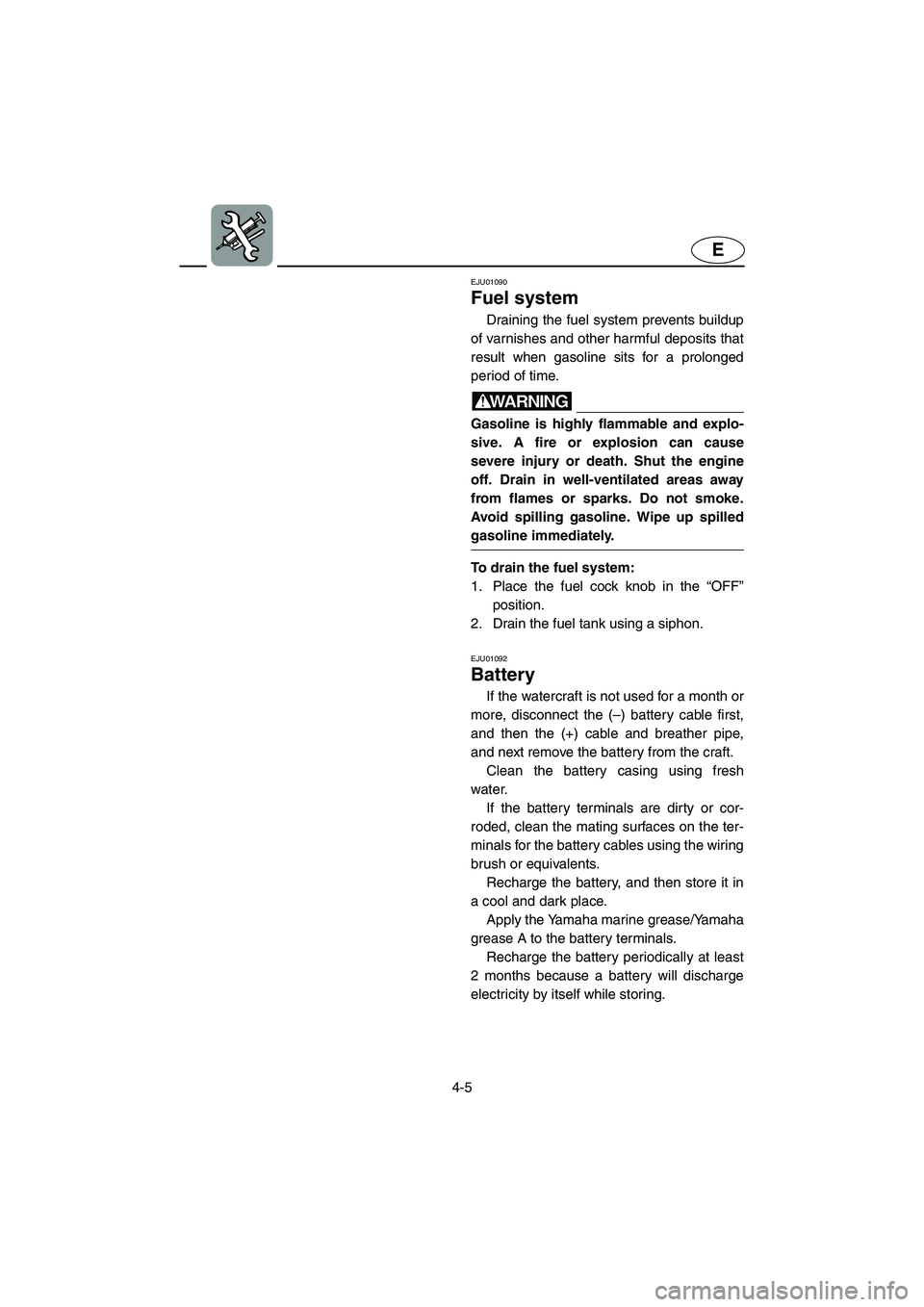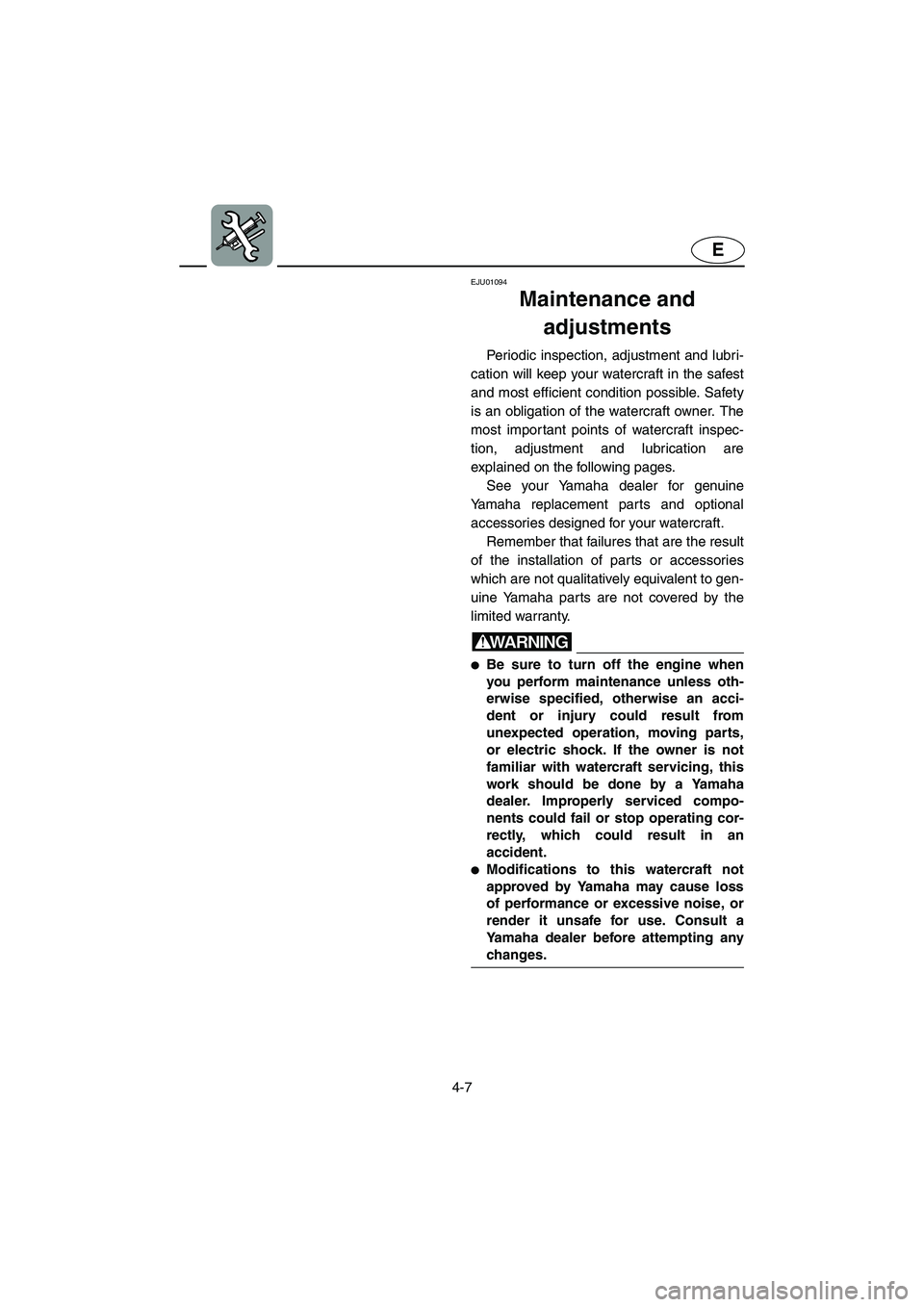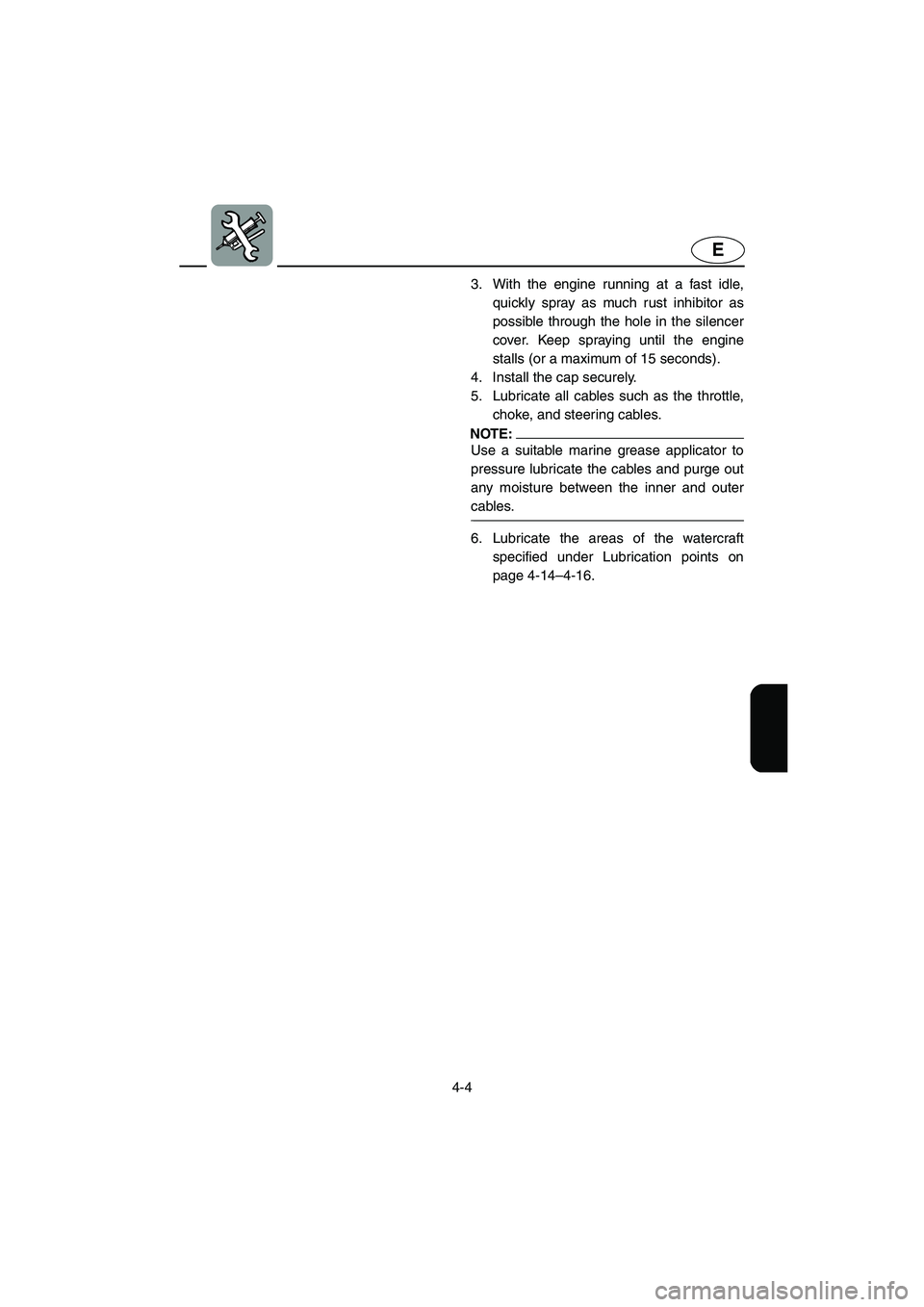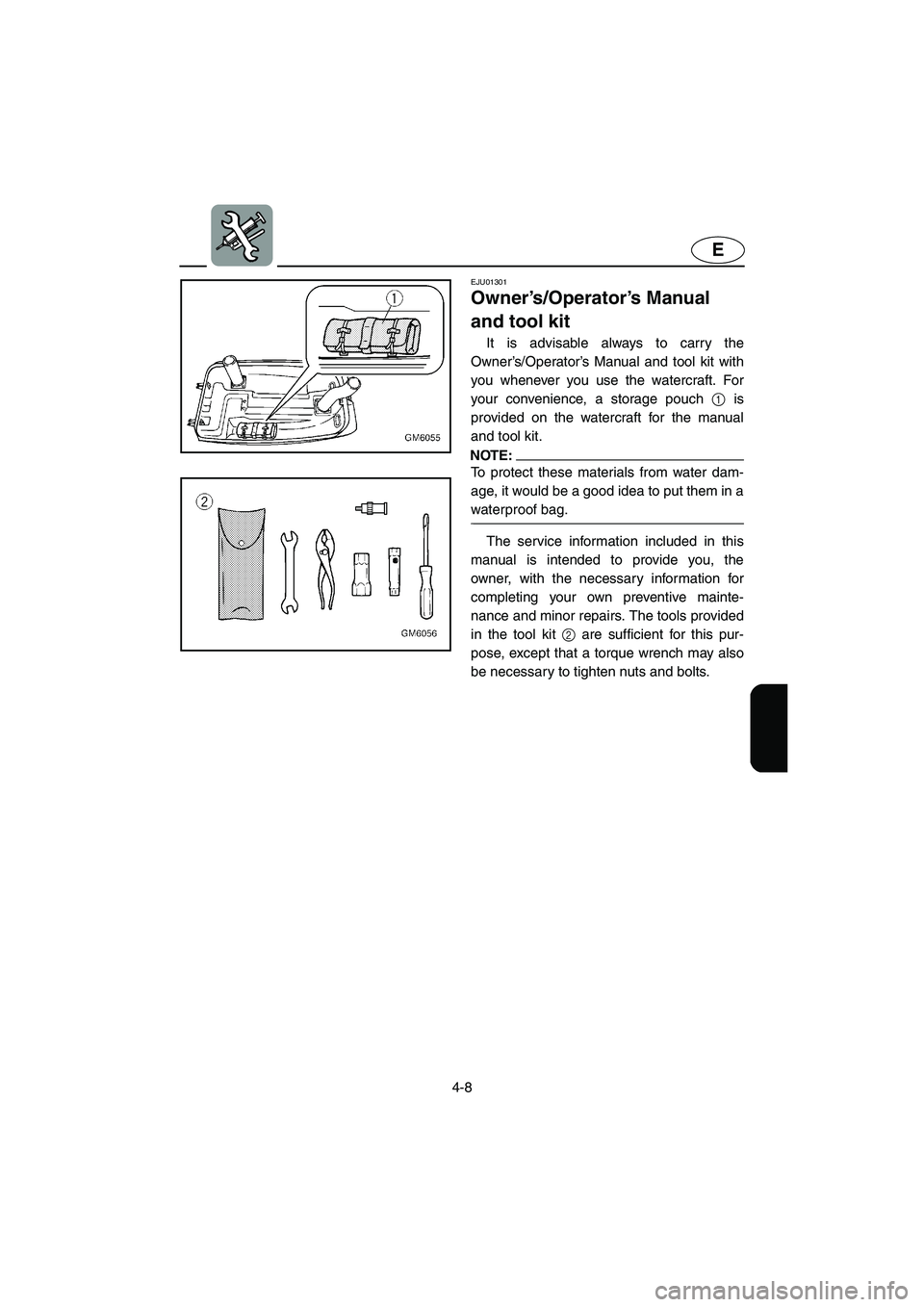Page 73 of 106
4-4
E
3. With the engine running at a fast idle,
quickly spray as much rust inhibitor as
possible through the hole in the silencer
cover. Keep spraying until the engine
stalls (or a maximum of 15 seconds).
4. Install the cap securely.
5. Lubricate all cables such as the throttle,
choke, and steering cables.
NOTE:@ Use a suitable marine grease applicator to
pressure lubricate the cables and purge out
any moisture between the inner and outer
cables.
@
6. Lubricate the areas of the watercraft
specified under Lubrication points on
page 4-14–4-16.
E_F1N-70.book Page 4 Wednesday, July 18, 2001 3:28 PM
Page 74 of 106

4-5
E
EJU01090
Fuel system
Draining the fuel system prevents buildup
of varnishes and other harmful deposits that
result when gasoline sits for a prolonged
period of time.
WARNING@ Gasoline is highly flammable and explo-
sive. A fire or explosion can cause
severe injury or death. Shut the engine
off. Drain in well-ventilated areas away
from flames or sparks. Do not smoke.
Avoid spilling gasoline. Wipe up spilled
gasoline immediately.
@
To drain the fuel system:
1. Place the fuel cock knob in the “OFF”
position.
2. Drain the fuel tank using a siphon.
EJU01092
Battery
If the watercraft is not used for a month or
more, disconnect the (–) battery cable first,
and then the (+) cable and breather pipe,
and next remove the battery from the craft.
Clean the battery casing using fresh
water.
If the battery terminals are dirty or cor-
roded, clean the mating surfaces on the ter-
minals for the battery cables using the wiring
brush or equivalents.
Recharge the battery, and then store it in
a cool and dark place.
Apply the Yamaha marine grease/Yamaha
grease A to the battery terminals.
Recharge the battery periodically at least
2 months because a battery will discharge
electricity by itself while storing.
E_F1N-70.book Page 5 Wednesday, July 18, 2001 3:28 PM
Page 75 of 106

4-6
E
CAUTION:@ The battery may be impossible to use
again if you store it for a longer time
without recharging. Recharge the battery
periodically.
@
NOTE:@ The battery condition can be found by
checking the specific gravity of the electro-
lyte. However, you can also know the battery
condition roughly by measuring the voltage
at both battery terminals. Recharge the bat-
tery if the voltage is 12 volts or less.
Yamaha recommend checking the specific
gravity of the electrolyte and charging bat-
tery by a Yamaha dealer or a battery dealer.
If you maintain the battery yourself, read
carefully the instructions for the tool and
machine before maintenance.
@
EJU01300
Cleaning the watercraft
Clean the watercraft before storing it for a
long period.
1. Wash down the hull, handlebars, and
drive unit with fresh water.
2. Rinse the engine and bilge area with
fresh water. Drain off all water and wipe
up remaining moisture with clean, dry
rags.
3. Spray the engine’s exterior with a rust
inhibitor and lubricant.
4. Wax the hull with a non-abrasive wax.
5. Wipe all vinyl and rubber components,
such as the engine compartment seals,
with a vinyl protectant.
6. Do not use protectant on the riding tray,
because it will make it slippery. Specific gravity of electrolyte
(for reference):
1.28 at 20 °C (68 °F)
E_F1N-70.book Page 6 Wednesday, July 18, 2001 3:28 PM
Page 76 of 106

4-7
E
EJU01094
Maintenance and
adjustments
Periodic inspection, adjustment and lubri-
cation will keep your watercraft in the safest
and most efficient condition possible. Safety
is an obligation of the watercraft owner. The
most important points of watercraft inspec-
tion, adjustment and lubrication are
explained on the following pages.
See your Yamaha dealer for genuine
Yamaha replacement parts and optional
accessories designed for your watercraft.
Remember that failures that are the result
of the installation of parts or accessories
which are not qualitatively equivalent to gen-
uine Yamaha parts are not covered by the
limited warranty.
WARNING@ �Be sure to turn off the engine when
you perform maintenance unless oth-
erwise specified, otherwise an acci-
dent or injury could result from
unexpected operation, moving parts,
or electric shock. If the owner is not
familiar with watercraft servicing, this
work should be done by a Yamaha
dealer. Improperly serviced compo-
nents could fail or stop operating cor-
rectly, which could result in an
accident.
�Modifications to this watercraft not
approved by Yamaha may cause loss
of performance or excessive noise, or
render it unsafe for use. Consult a
Yamaha dealer before attempting any
changes.
@
E_F1N-70.book Page 7 Wednesday, July 18, 2001 3:28 PM
Page 77 of 106
4-8
E
EJU01301
Owner’s/Operator’s Manual
and tool kit
It is advisable always to carry the
Owner’s/Operator’s Manual and tool kit with
you whenever you use the watercraft. For
your convenience, a storage pouch 1 is
provided on the watercraft for the manual
and tool kit.
NOTE:@ To protect these materials from water dam-
age, it would be a good idea to put them in a
waterproof bag.
@
The service information included in this
manual is intended to provide you, the
owner, with the necessary information for
completing your own preventive mainte-
nance and minor repairs. The tools provided
in the tool kit 2 are sufficient for this pur-
pose, except that a torque wrench may also
be necessary to tighten nuts and bolts.
E_F1N-70.book Page 8 Wednesday, July 18, 2001 3:28 PM
Page 78 of 106

4-9
E
EJU01355
Periodic maintenance chart
The following chart gives general guidelines for periodic maintenance. However, depend-
ing on your operating conditions maintenance may need to be performed more frequently.
*1: Grease capacity: 20.0–22.0 cm3 (0.68–0.74 oz)
*2: Grease capacity: 3.0–5.0 cm3 (0.10–0.17 oz)
(�) This mark indicates maintenance that you may do yourself.
(
❍) This mark indicates work to be done by a Yamaha dealer.
MAINTENANCE INTERVAL INITIALTHEREAF-
TER EVERYPA G E
10
hours50
hours100
hours 100
hours 200
hours
ITEM
3
months6
months6
months12
months
Spark plug Inspect, clean, adjust ����
4-13
Lubrication points Lubricate��
4-14
Intermediate housing Lubricate❍
*1�
*2�
*2 4-16
Fuel system Inspect❍❍
4-10
Fuel filter Check, replace❍❍
4-11
Fuel tank Clean❍
4-11
Carburetor setting Inspect, adjust❍❍❍
4-19
Trolling speed Adjust��
4-19
Carburetor throttle shaft Inspect❍❍
—
Cooling water passages Flush�
(after
ever y
use) 4-1
Bilge strainer Clean���
—
Impeller Inspect���
—
Steering cable Inspect��
4-12
Steering pivot Inspect❍❍❍
—
Steering friction Inspect���
4-20
Throttle cable Inspect, adjust��
4-12
Choke cable Inspect, adjust ��
4-16
Battery Inspect�
(Inspect
fluid level
before
ever y
use)4-17
Rubber coupling Inspect❍
—
Nuts and bolts Tighten❍❍❍
—
E_F1N-70.book Page 9 Wednesday, July 18, 2001 3:28 PM
Page 79 of 106
4-10
E
EJU01383
Inspecting the fuel system
WARNING@ Gasoline is highly flammable and explo-
sive. A fire or explosion can cause
severe injury or death. Shut off the
engine. Do not smoke. Avoid spilling
gasoline.
@
Check the fuel system for leaks, cracks,
or malfunctions. If any problem is found, do
the necessary repair or replacement as
required. If repair is necessary, consult a
Yamaha dealer.
Check:
�Carburetor for leakage.
�Fuel pump for malfunction or leakage.
�Fuel tank for water or dirt.
�Fuel tank for damage, cracks or leakage.
�Fuel hose joint for leakage.
�Fuel hose for cracks or other damage.
�Fuel filter for leakage.
�Fuel cock for leakage.
�Air vent check valve for leakage.
�Fuel tank filler cap for damage.
WARNING@ Failure to check for and repair any fuel
leakage may result in fire or explosion.
@
E_F1N-70.book Page 10 Wednesday, July 18, 2001 3:28 PM
Page 80 of 106
4-11
E
EJU01098
Fuel filter
This watercraft is equipped with a one-
piece, disposable fuel filter 1. The fuel filter
should be replaced once a year or after
every 200 hours of operation, or if water is
found in the filter. Have a Yamaha dealer
replace the fuel filter if necessary.
WARNING@ Do not try to replace the fuel filter your-
self. An incorrectly installed filter can
leak gasoline, which could lead to fire or
explosion. If necessary, have a Yamaha
dealer replace the fuel filter.
@
EJU01099
Fuel tank
Check the fuel tank 1 for leakage or
water in the tank. If water is found in the fuel
system or if the fuel tank needs to be
cleaned have a Yamaha dealer service the
watercraft.
E_F1N-70.book Page 11 Wednesday, July 18, 2001 3:28 PM
 1
1 2
2 3
3 4
4 5
5 6
6 7
7 8
8 9
9 10
10 11
11 12
12 13
13 14
14 15
15 16
16 17
17 18
18 19
19 20
20 21
21 22
22 23
23 24
24 25
25 26
26 27
27 28
28 29
29 30
30 31
31 32
32 33
33 34
34 35
35 36
36 37
37 38
38 39
39 40
40 41
41 42
42 43
43 44
44 45
45 46
46 47
47 48
48 49
49 50
50 51
51 52
52 53
53 54
54 55
55 56
56 57
57 58
58 59
59 60
60 61
61 62
62 63
63 64
64 65
65 66
66 67
67 68
68 69
69 70
70 71
71 72
72 73
73 74
74 75
75 76
76 77
77 78
78 79
79 80
80 81
81 82
82 83
83 84
84 85
85 86
86 87
87 88
88 89
89 90
90 91
91 92
92 93
93 94
94 95
95 96
96 97
97 98
98 99
99 100
100 101
101 102
102 103
103 104
104 105
105






